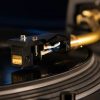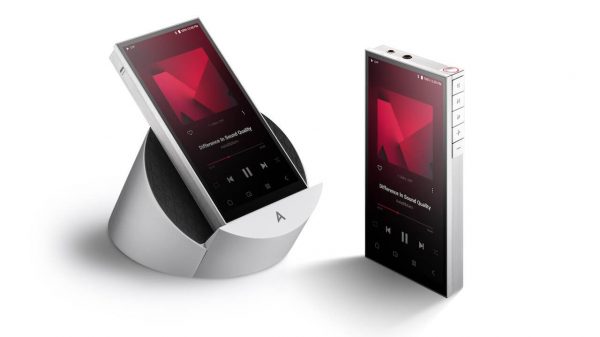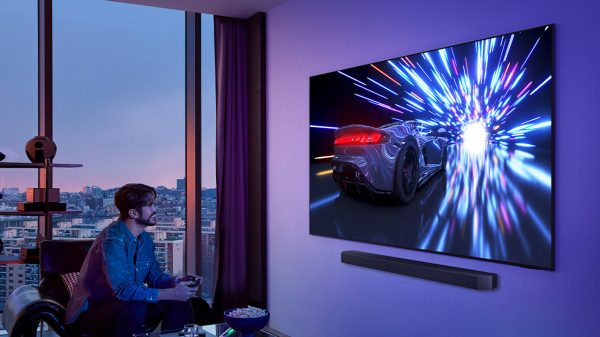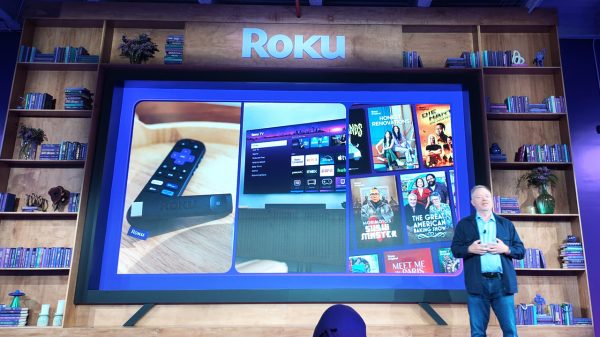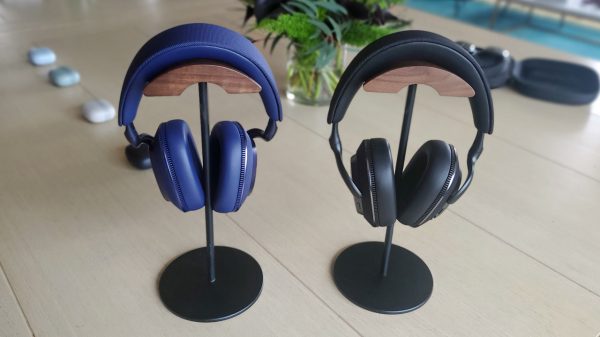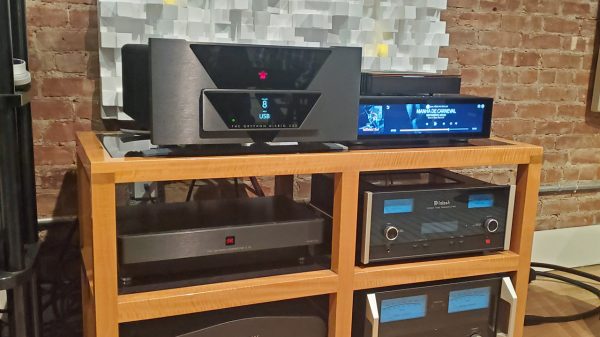Astell&Kern remains the top player in the boutique DAP market with the A&Ultima lineup showing just how good portable sound can be if pockets are deep enough.
The most recent was the SP3000 which saw the first use of the new Asahi Kasei (AKM) 4499EX DAC chip and allowed A&K to completely segregate the analog signal processing from the digital side of the house.
The result of their efforts was as visually stunning as it was musical. Listening to the SP3000 was one of those experiences that jades you because once you know what can be, it is hard to go back to reality.
$3,500 USD is a lot of money for any source device, let alone a portable one, and that reality was not lost me as I boxed it up and returned it.
Still for me, while I really enjoyed the SP3000, my choice of the bunch was the SP2000T; the slightly warmer tone created by the use of tubes in the design would be my long-term personal preference.
The SP2000T was a follow-on to the SP2000 that incorporates a pair of sub-miniature pentode tubes and gives the user the option of the SP2000 signature or a bit more of an analog sound by adding the tube pre-amp to the signal path.
For me, the SP2000T was the best of all worlds as I could use the digital mode for absolute precision when reviewing and the tube mode when listening for pleasure. If spending this kind of money, it is important to cover as many use cases as possible in a single purchase so the SP2000T got my nod.
Well, until now.
Interestingly, the JAN 6418 sub-miniature pentodes used in most portable gear today are one of a precious few tubes that were designed from the outset to be used in portable, wearable devices (namely hearing aids).
That is pretty remarkable considering the tube was designed in the late 1950s and was in production by 1965. The forward thinking nature of the design is rather intriguing.
Not long ago, Astell&Kern asked if I’d be interested in a quick turn-around review of the brand new SP3000T which promised to upset the applecart once again.
We immediately agreed as the SP3000 is truly an impressive upgrade to the SP2000; if A&K had managed to combine the best aspects of the SP3000 with the tube sound I enjoyed in the SP2000T — this could be the endgame DAP from the Korean manufacturer.

The SP3000T comes boxed in a lavish wood presentation box with the DAP in the lower portion and a box tucked in the top portion with the requisite cable, case, and manual.
The DAP itself is hidden behind a sticker over the screen and encased in a translucent bag so one does not get the full experience when opening the case the first time.
Once removed, the player is stunning with its 5.5-inch hi-res screen taking up nearly the entire front and the silver plated frame with its angular elements typical of A&K reflecting various colors from around the room.
At first, many will think it is the same frame as the SP3000, but when side by side the latest iteration is slightly larger in height and width, thinner, but amazingly almost the same weight as the original.

The rear face is very different with a black glass panel on the top covering roughly 5 cm and a charcoal gray panel with the A&K name emblazoned covering the lower portion.
There is a window in the cover that exposes most of the upper black glass panel as this is where the tubes are and it allows viewing the LED backlit tubes when they are in use.
Audio ports are on the top surface with 3.5mm, 4.4mm, and 2.5mm port options from left to right and the power button is positioned on far right.

The left side has 4 buttons, the top being to control the amp and the next three being back, play/pause, and forward. The right side houses the volume knob protected by a raised lip on either side.
The bottom surface houses a USB Type-C charge and data port and a micro-SD slot.
The slot had no issue supporting my 1 TB Sandisk card giving a total of 1.25 TB storage when combined with the internal 256 GB of space
One change that most will notice is whilst the original SP3000 used a highly polished 904L steel chassis, the SP3000T uses a 99.9% pure silver plating over a 316L steel frame.

More recently, a 99.98% pure copper chassis option has also been introduced for those who prefer the warmth of copper. Silver provides better conduction than gold or copper but also is subject to tarnishing so the SP3000T uses a multi-layer coating on the chassis to help prevent sulfurization and darkening of the silver.
I can attest to the beauty of the silver plated chassis, but for those who are harder on their equipment, the 904L chassis of the original SP3000 is likely a bit tougher than the SP3000T.
Since most DAPs spend 95% of their life in some form of protective case, and a really nice one is provided with the SP3000T, I have no reason to worry about the new models longevity, but I also tend to take better care of my DAPs than some.
You won’t find mine bouncing around in a backpack or bike-bag.

The shrunken calfskin case protects the SP3000T quite well and allows the user to see the tubes at the same time which also helps with keeping the tubes cool.
Like other recent SP models, the crown-patterned volume wheel operates as the on/off switch with a long press required to turn the player on/off and users now see a confirmation screen to avoid any accidental shutdown of the unit whilst listening.
A short press of the button turns off the display which is advisable because leaving it on puts a substantial drain on the battery; I found in my listening tests that if I left the screen on to view the lyrics or album art, I lost roughly an hour worth of battery life over my standard 2-3 hour listening session.
Losing sixty minutes of listening time with the display left on felt rather significant considering the price of the unit.
I remain impressed with the volume wheel used by A&K and feel other manufacturers should use this as their their benchmark as the wheel has enough resistance that it won’t move accidentally and changes feel very deliberate, yet it remains easy to adjust with a single finger.

The 150 step range is also class leading and something I very much appreciate when switching between IEMs and harder to drive over-ear headphones.
Likewise, the buttons are firm enough to avoid accidental clicks and provide good tactile feedback, although I did find the case reduced that tactile feeling of the buttons and made them a bit harder to find without looking directly at the player.
It would make more sense for the leather to be thinner at the button positions to allow better feedback, but this also would make the case a bit less protective and more damage prone so I understand the choice.
So externally and material wise, the SP3000T has more in common with the SP2000T than it does with the SP3000, but that isn’t the case when we look inside the SP3000T where it is every bit a 3000 series device.
Technology
Although the SP3000 uses quad 4499EX DACs and dual 4191 delta/sigma chips, the SP3000T drops down to dual 4499/dual 4191. Otherwise, both models have same CPU (Snapdragon 6125 octa-core processor), RAM (8GB) and storage (256GB).
Dual band wireless with 802.11ac support is also standard so those who prefer to stream music rather than load micro-sd cards will find the SP3000T quite capable.
AK connect offers all of the popular streaming services and I tested with TIDAL and Qobuz and found both to be easy to use and update when needed.
The SP3000T supports up to 32-bit/768kHz PCM and 22.4Mhz DSD (DSD512) and will decode MQA if desired.

The biggest internal difference in the SP3000 and SP3000T is the new Triple Amp System. Like the SP3000, the SP3000T offers Teraton Alpha amplifier modules keeping each channel distinct and isolated, but the SP3000T adds the Raytheon 6418 tube option for those who want a pure tube sound and a hybrid option for those who want a bit of tube warmth without getting too syrupy.
The listener has the option of switching between amplifiers via the user interface and the tubes are lit only when the player is in tube or hybrid mode which gives a nice visual as well.
With the VU meter display option on one side and the tube glow on the other, it can be difficult to choose which side of the SP3000T one would rather look at.
Bluetooth is version 5.0 with aptX HD and LDAC and LHDC support in addition to SBC, so those wishing to use wireless headphones or stream to the SP3000T are not left out.
When enabled Bluetooth is set to pair to headphones or earphones in transmit mode. Turning on the BT-Sync option puts Bluetooth in receive mode and allows streaming from laptop, phone, or even a TV to the DAP.
The SP3000T features the same 5050mAh battery as its parent which gives roughly 10 hours when using the solid state amplifier and a bit less when using the tube module.
Quick charge is supported, but a full charge still takes roughly 2.5-3 hours using a 2.1 amp charger.
Using a standard 500mA USB port will require roughly 9 hours to fully charge the SP3000T.
Interface
Like previous models, the SP3000T uses A&K’s stripped down Android OS with the Crimson UI/UX theme that is arriving in all the new A&K DAP releases. The removal of unnecessary Android components helps to improve sound quality and battery life, but does mean that installing apps on the A&K players requires a few different steps compared to full Android devices.

It also requires that users check the compatibility list as not every Android app will work on A&K players. This curation of apps via the Open App Service allows A&K to vet applications to be sure they don’t harm performance of either the UI or sound before allowing install on the player, thus safeguarding listeners from a degraded experience.
When first powered on, the SP3000T displays the Astell&Kern logo for roughly 20 seconds as the operating system loads. Once completed, the user is greeted by the main playback screen. If the unit had previously been in use, the listener can simply push play and pick up right where they left off.
The playback screen is well laid out making it easy to use the touch controls without risking hitting the wrong thing, and is very responsive with no notable delay in reacting to touch commands.
During playback, the top half the screen shows the embedded cover art and the lower half displays the playback controls and the operating system buttons. Tapping the album art takes the user to the lyrics if available, while swiping left or right will advance the track or go backward to the previous one.
The file type, bit depth and sampling rate can all be clearly seen between the artwork and the title along with a heart icon for adding a song to the favorites playlist.
The volume knob is also illuminated by an LED that gives a visual indication of the file type and bit depth of the track; Red is 16 bit, Green is 24, Orange is 32 and purple is DSD.
For those wishing to conserve a bit of battery life, the LED can be disabled in the settings.
Navigation to other menus is handled by pressing “A” in the upper left corner of the screen or by swiping the main screen right which opens a list of options.
All of the music search options offer further customization and allow users to decide how and what they look for. Folder view and MQS provide alternate views of the files either by location or quality as well, and CD-library works with the A&K Ripper to directly load CDs onto the player.
The “services” and “settings” tabs open up a much wider range of options including access to streaming platforms; the SP3000T works in conjunction with the Open APP service (as previously mentioned) and allows users to load and update the various streaming services.

TIDAL came pre-installed on the test unit and I added Qobuz, Spotify, Amazon, and Apple Music.
Just be aware that it did require a reboot of the unit for Qobuz to be operational.
There are currently 30+ streaming services in the Open App library and for the adventurous, APK files can be loaded, but be aware that loading APKs does not guarantee that they will work correctly.
TIDAL offline is not supported on the embedded version of TIDAL due to contractual obligations between TIDAL and the music labels regarding third-party TIDAL integration and DRM. However, the full TIDAL Android app can be installed from the download tab that supports full offline mode. The official TIDAL Android and iOS apps are the only TIDAL apps approved by the record labels for offline mode.
Most users will find the functions they use frequently can be quickly accessed via the notification bar accessed by swiping down at the top of the screen. The notification bar allows toggling between Wi-Fi and Bluetooth, enabling the EQ, changing USB mode, enabling AK Connect, DAR, changing amplifier modes, and turning line-out on or off.
Sound Sculpting
DAR may be unfamiliar to some and some explanation is required; A&K’s up-sampling technology is called Digital Audio Remastering, and when enabled 44.1kHz PCM files are upsampled to 352.8kHz and 48kHz files are upsampled to 384kHz when in PCM mode.
In DSD mode, PCM files below 96kHz are upsampled to DSD128, PCM over 96kHz are upsampled to DSD256 and DSD files below 256 are upsampled to DSD256.
For purists, DAR can be simply disabled and the track listened to exactly as provided, but for those wishing to sculpt the sound, DAR provides another tool along with EQ and filters.
Like its parent, the SP3000T makes all 6 digital filters accessible to the listener so they can tweak the sound.
I found the short delay sharp to be my favorite but would encourage listeners to adjust and try them all. Differences are subtle, but audible.
The default EQ offers a 20 band fixed EQ which is more than most competitors offer and there is a quasi-parametric EQ (the bandwidth is fixed) for those wanting even more control.
If between 3 amplifier options, 20 bands of EQ, 6 filters, and DAR the listener cannot arrive at a sound profile that suits their needs, perhaps a visit to the audiologist is in order.
Connections
The fastest way to get to listening on the SP3000T is to pop in a micro-sd card full of FLAC files and plug in a set of earphones. At that point, all that is left is hit random and play on the main screen.

Wireless headphones and earphones take a minute or two to pair before hitting play, but the process is painless and the display shows the codec in use; Sony XM5 paired via LDAC, and the B&W Px8 used Bluetooth aptX HD.
Switching Bluetooth to Sync mode allowed for easy connection to my laptop and Apple iPad using SBC which was surprisingly stable.
The SP3000T can also be used as a USB DAC/Amplifier by connecting the USB port to a source device. Again, connecting my laptop allowed for playback using foobar directly to the SP3000T.
The SP3000T can also be used as a digital transport for those with home systems containing top end DACs.
The SP3000T provides as good or better DAC as found in many home systems so the uses cases for using the SP3000T as a digital transport are fairly uncommon.
In either case, the USB mode needs to be set via the notification panel to make sure the mode is correct; connecting the DAP to a PC in default mode, exposes the storage as drive space.
The 3.5mm port also serves as a line out for connecting to an external amplifier just be careful not to enable this mode with a headphone attached as damage to the headphone and the listener will occur.
Sound

We tried the SP3000T with a number of different headphones and IEMs to get a sense for how this rather expensive DAP performs with a rather wide range of models; including some of the best wireless headphones currently available.
Starting out with headphones, we paired the Beyerdynamic T5p (2nd generation), the HiFiMAN HE1000se, Fostex TH909, and the AKG 240 Sextet which at 600+ ohms might be pushing the limits of a portable.
On the earphone side, we used the Ultimate Ears Premier, Empire Ears Wraith, the Campfire Andromeda, Letshuoer Cadenza 12, and the Westone Mach 70. All of these represent the upper end of IEM performance which is what a typical SP3000T owner might already own.
Wireless models included the Sony XM5, Bowers & Wilkins Px8, Bose NC700, and Focal Bathys.
The Beyerdynamic T5p (2nd generation) are a rather revealing pair of headphones and it was clear right away that the pure tube mode was the best match; whilst bass had good depth and texture with all of the settings, that particular setting offered greater impact and that carried over into the midrange.
The midrange was pushed slightly forward in tube mode which helped with the Beyerdynamic headphones; there was additional texture and presence and most vocals sounded more natural.
Top end performance was also quite good without any noticeable loss of detail and with enough clarity and extension.
One of the benefits of the treble performance and overall clarity was that listeners experience a much larger sounding soundstage; depth, width, and overall soundstage height were excellent.
Average listening volume was reached at right around the mid-point on the volume knob leaving plenty of headroom. The A&K DAP will not run out of gas with these headphones.

Having owned these headphones for a number of years, this may have been one of the best experiences I have had with them using a rather wide range of sources; you would be hard pressed to make the T5p sound any better.
Planar Fun or Misery?
Full-sized planar magnetic headphones are not the easiest load and that is certainly true of the HiFiMAN HE1000. The past pairing here was with the SP3000T used in solid-state mode; and even with that I required some EQ to smooth out the top end of the HE1000se.
Having used these headphones for a rather long time, I am rather aware of their inherent peak at 6kHz and another one around 10kHz that can sometimes cause a tonal inaccuracy in the top end.
Going to Hybrid mode helped the treble, but hurt bass clarity enough that I decided to go back to the solid-state and EQ the treble rather than impact the overall signature.
Overall, with a little EQ, it’s a good listen although the HE1000se does demand closer to two-thirds of the volume range to reach slightly above average listening levels.
The Fostex TH909 provides yet another different load with a driver that is both easy to drive technically (25 ohms and 100dB/mW) and power-hungry as it has a max input power of 1800mW.
With enough power, the TH909 has slam like few others and just begs for something raucous. These are guilty pleasure headphones for when you really want to enjoy Primal Scream, Metallica, or something bombastic and not focus on overall neutrality. Hybrid mode was the best choice for those who want to experience bass response that is controlled, detailed, but also full of texture and overall impact.
You did have to turn the volume up with the Fostex to really experience what they are capable of with this type of DAP.
The AKG 240 at 600 ohms is a test for any portable device but the SP3000T handled it easily and it was the best of the group in pure tube mode as it really let the AKG shine with good bass impact and it helped tame the treble range which was a better way to run with these headphones.
In testing IEMs, I found that the more sensitive models like the Premier and Andromeda did show hiss when in tube mode and are best in either hybrid if you can ignore a bit of background noise between tracks or in pure solid-state mode for a cleaner noise floor.
The Andromeda which is known for being hyper-sensitive requires only one-fourth of the available volume to be at full listening levels and often I was a bit below that when listening to background music while working.
The UE Premier can use a touch more volume but still doesn’t need much over one-third of the available range. The UE IEMs displayed an excellent sense of balance with a rather strong and robust bass range, clear midrange, and rather extended highs.
The soundstage is wider sounding than it is deep, but the sense of space is excellent for a custom IEM.
The Empire Ears Wraith was my favorite pairing with the original SP3000 so I had to see if the SP3000T could match it. In solid state it does, but takes just a bit more volume than my notes showed for the same tracks with the SP3000.
The Wraith has a holographic soundstage when paired with the SP3000T. Tonality is also quite good and very natural sounding with good depth at the low end, great extension at the top end, and seemingly endless detail in between.
I didn’t find the tube modes to add much to the mix and quickly returned to the default mode that worked so well with the Wraith.
The Cadenza 12 also qualifies at extremely sensitive with its 16 ohms and 100dB/mW rating and similar to the Andromeda is best in solid-state mode with plenty of volume range left untouched as it reaches “too loud” extremely quickly.
One of the best features of the Cadenza is a very natural tonality which was on full display. The soundstage was also well proportioned if not particularly large in any single dimension.
The Westone Mach 70 is in some ways the IEM equivalent of the TH909 with a high sensitivity but a bit higher impedance as well and here I found myself using a bit more of the volume range to get to listening levels but still well below half of the available range.
Those looking for bass power in an IEM will appreciate the Mach 70 and the SP3000T did a good job of providing enough texture to keep the sub-bass from sounding overly thick.
Once volume levels were set and modes selected, the SP3000T did well with all of the IEMs. The Andromeda sounds more balanced with the SP3000T than with the SP2000T where it had some issues with the mid-bass and hiss.
Streaming to the wireless headphones (or when physically connected) was a very different scenario for the simple reason that all of them were adding their own internal processing.
All of the wireless models worked well but that the selection of the different amplification modes made little if any difference in what was heard.
For that reason, I’d suggest sticking with the solid-state mode and conserving the battery when using the SP3000T with wireless devices.

Final Thoughts
Does it make sense to spend $3,000 on a DAP?
I think that really depends on the types of headphones or IEMs that are going to be on the other end and if something like the Astell&Kern SP3000T is going to be your long-term daily driver.
My overall take is that the SP3000T shares a rather similar tonality with the A&K SP3000 when used in solid state mode; both exhibit a rather neutral tonal balance with excellent transparency and most instruments have rather accurate sounding timbre.
When one switches to tube mode (full or hybrid), that changes somewhat with an additional layer of warmth that is evident throughout the range, but especially in the midrange where vocals become more organic sounding and string instruments have a lot more texture and presence.
There is no question that the Raytheon 6418 tubes have a significant impact on the overall sound and when spending $3,000 on a DAP – a little versatility is not a bad thing. Being able to switch back and forth became rather important when listening to such a large variety of headphones and IEMs.
Astell&Kern believes that the SP3000 is the best DAP they have ever produced. Does the SP3000T offer more of the same in a more affordable package or does it offer greater versatility that might prove to be beneficial to listeners long-term who may switch to different types of headphones and IEMs?
We know which one we would select.
For more information: astellnkern.com
Where to buy: $2,999 at B&H Photo | Audio46 (save 5% with code: ecoustics)
Related Reading:


